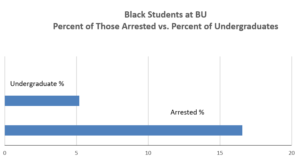SUNY-Binghamton University (BU) now has a larger police force than any of the surrounding cities of Endicott, Johnson City, or Vestal. Only Binghamton, where many students live and where the University funds additional city police, has more.[i]
Recent protests against racial profiling and assault at Binghamton High School highlight studies showing that adding police and security forces accelerates racial profiling and racialized punishment of students, and fails to stop bullying, drug use, or conflict. Is something similar true for BU?
In response to a Freedom of Information Act request, the University responded that the BUPD does not record stops on campus, and certainly not by race, ethnicity or gender. To be fair, neither does the City of Binghamton where city councilpersons have rejected a proposal to do so. Nor does the University admit to having any similar records for campus disciplinary procedures. Where such data are revealed, as for stop-n-frisk in New York City, the public protest has been vigorous–and led to changing the policies imposed by police chiefs and actual policing practices.
The one statistic that cannot be avoided however is arrest data. It is reasonable to ask: What percentage of the student population at SUNY-Binghamton is Black, and what percentage of arrests by the BUPD are of Black persons? We know from long-term national studies that Black youth generally commit harmful acts at rates no higher than other population groups, and that the Black youth use drugs, a major campus “crime,” at lower rates than white youth.[ii]
Here is the situation from the available and admittedly poor data we have:

These data naturally lead to further questions: how does the University Administration and the BU Police Department explain such disparities? And why can’t we find out the number, race, and ethnicity of persons stopped and questioned on campus, and disciplined on campus? It isn’t for a lack of resources: there has been a proliferation of offices, staffing and funding related to not just policing but so-called diversity programs on campus (is the number of Black students that low?). Is there something else hidden here?
[i] As reported by the NYS Division of Criminal Justice Statistics for 2017, the total personnel counts are: SUNY-Binghamton 55, Endicott 37, Johnson City 44, Vestal 37, and Binghamton 151.
[ii] See among others Bruce Western, Punishment and Inequality in America (New York: R. Sage Foundation, 2006), 44–47.
Leave a Reply